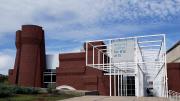Joseph Giovannini, M.Arch. ’74, writer and architecture critic, conceived the neologism “Deconstructivism” to describe the changes, social and technological, that brought chaos into the very formal work of designing habitable buildings. He has spent more than three decades, on and off, distilling the roots, meanings, and applications of what he meant, and subsequently discovered. The result is the gargantuan (8 pounds plus), breathtaking, gorgeous, and surely definitive Architecture Unbound: A Century of the Disruptive Avant-Garde: Transgressive, Oblique, Aberrant, Deconstructed, Digital (Rizzoli, $50). Ranging far beyond Gehry, Hadid, and Koolhaas, it puts in context such iconic structures as the European Central Bank tower, in Frankfurt, and the Scottish Parliament Building, in Edinburgh. And he can write. From the introduction:
When Virginia Woolf wrote that human character had changed in 1910, she was remarking on the deep shift in relations between husband and wife, parent and child, master and servant, inferring, “when human relations change there is at the same time a change in religion, conduct, politics, and literature.”
Woolf was writing about the cusp of modernity, as forces of industrialization, capitalism, and scientific progress culminated in technological inventions—the telephone, automobile, airplane, radio, and electricity—that converged with parallel innovations in the arts such as Fauvism, Cubism, Expressionism, and Futurism, shifting culture onto a different footing. Socially the established order had been under siege for a generation, with inventions in contraception and abortion and with challenges to religious dogma, scientific truth, and the very notion of objectivity.…More tolerant and even open to the “other,” Parisian “society” absorbed outsiders: homosexuals, Jews, provincials, foreigners, and women who might politely be called ambitious. By 1913, Serge Diaghilev staged Igor Stravinsky’s Le Sacre du printemps to uproar, and Apollinaire wrote Alcools and his treatise on Cubism.…
But in the early 1980s, Woolf could have rewritten the same sentence about …a second major shift…bringing with it changes in religious, conduct, politics, mores—and architecture….
As culture changed, architecture changed. In or about 1983, a half-dozen unusual projects embodied and expressed the cultural shifts. A gentleman’s club in Hong Kong, a park in Paris, a university art gallery in Columbus, Ohio, a manifesto drawing in a New York show, and an artist’s studio in Vienna broke through the surface, semaphores of change. Two earlier private structures, a house in Santa Monica and a small cultural center in rural Austria, anticipated 1983, radical architectural events just erupting into view. Private and public, small and large…the buildings abruptly pioneered a new way of conceiving and perceiving buildings.
They arrived by stealth.








